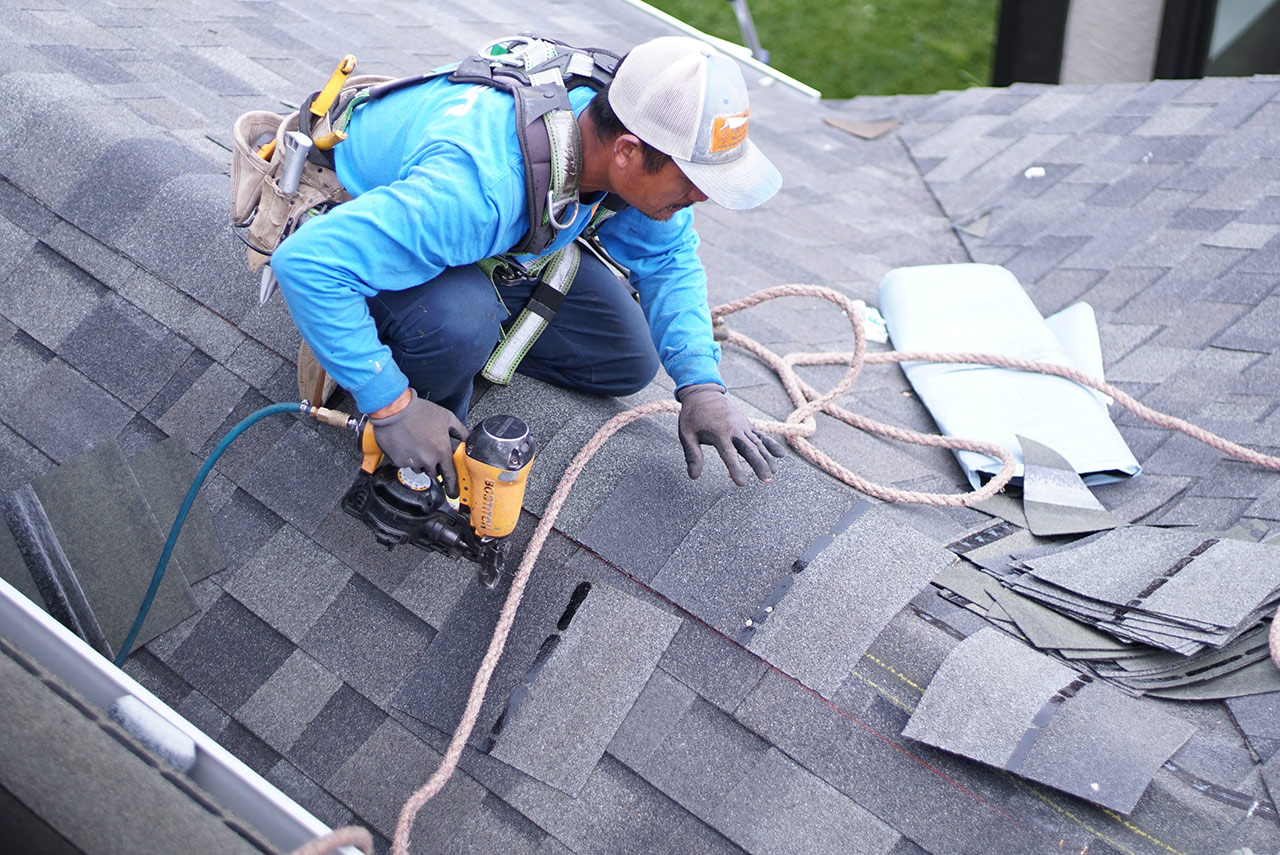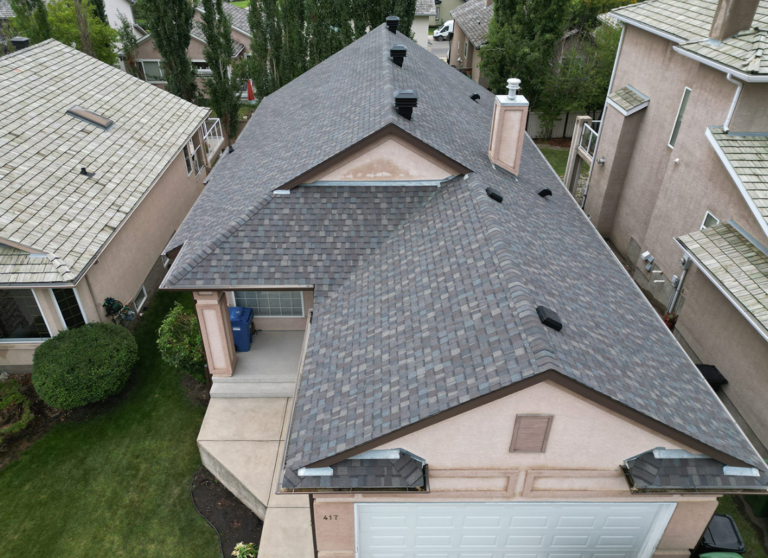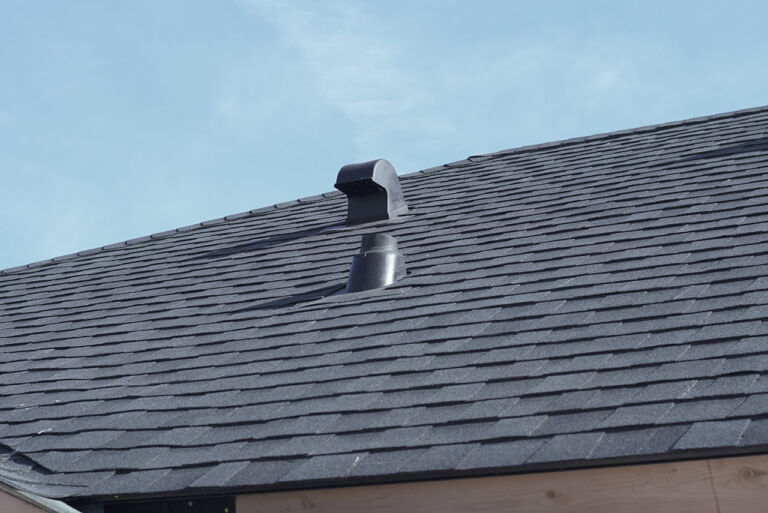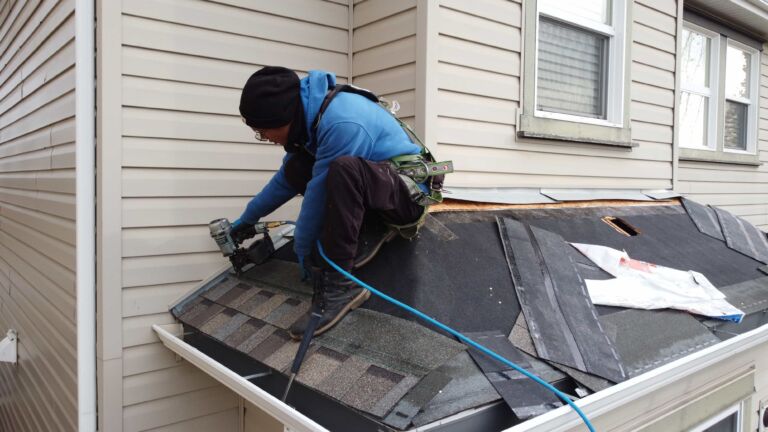
Residential roof repair is a vital responsibility for every homeowner. Your roof shields your home from the elements. It is the first line of defence against wind, rain, hail, and snow. If your roof has issues, your house is at risk. At No Payne Roofing in Calgary, Alberta, we have seen how small roof problems can lead to big headaches if left unaddressed. That is why staying informed about residential roof repair is wise.
You deserve a solid roof that gives you peace of mind. When you keep your roof in good shape, you protect your investment. You also increase the overall comfort of your home. You can avoid expensive damage. You can reduce stress. You can maintain your property’s value. You also help preserve your home’s appearance.
- A well-maintained roof can last much longer
- Roof problems worsen over time if ignored
- Minor repairs can prevent serious complications
Table of Contents
Effective residential roof repair starts with awareness. You want to know what warning signs to look for. You want to understand your roof’s materials. You also want to know how to act when trouble appears. You can learn to spot curling shingles, missing pieces, and other clues. These signals can show that your roof needs attention. Armed with this knowledge, you can make sound decisions about your roof’s future.
- Be attentive to visible changes in your roof
- Look for water stains on ceilings or walls
- Inspect your attic for any signs of leaks
Below, you will find a clear roadmap of what you need to know in 7 smart tips. We will cover various topics, such as roof inspections, materials, repair steps, cost factors, and preventive measures. Each section will provide targeted details to guide you in caring for your roof. The focus will always be on residential roof repair. Our goal is to give you practical tips that make sense to you, especially if you live in a place like Calgary, where the weather is unpredictable.
- Understand how weather affects your roof repair needs
- Learn practical steps to extend your roof’s lifespan
- Get tips for navigating contractor conversations
By taking charge of your residential roof repair, you can save money. You can also keep your family safe. You can ensure that your home remains comfortable. And you can dodge many roof-related problems that catch people by surprise. So, dive into these points. Absorb them. Refer back to them when needed. Think of this as your toolbox for everything related to your residential roof repair journey.
1. Knowing Your Roof’s Materials
Different roofs use different materials. Common choices include asphalt shingles, metal panels, cedar shakes, and tile. Each material has its strengths and vulnerabilities. In Calgary, many homeowners choose asphalt shingles because they are cost-effective and easier to install.
- Asphalt shingles can last around 20 years with proper care
- Metal roofs are more durable but cost more upfront
- Cedar shakes add natural charm but require routine maintenance
If you know your roof’s material, you can anticipate likely issues. You can also schedule the right kind of maintenance. Asphalt shingles, for instance, might curl or lose granules. Metal roofs may form rust spots if not treated. Cedar shakes may rot if they absorb too much moisture. When you know the potential hazards, you can respond quickly.
- Curling shingles can signal advanced aging
- Rust spots on metal roofs need immediate treatment
- Rotted cedar shakes weaken othe verall roof structure
Your roofing material also affects the tools and methods used during a repair. Some repairs are simple, like replacing a few missing shingles. Others need specialized techniques, such as sealing metal seams or removing and replacing cracked tiles. For any roof type, learning about the material is your first step in effective residential roof repair.
- Research your specific roofing product and its expected lifespan
- Know which issues your material is prone to
- Identify appropriate repair techniques for your roof type
2. Recognizing Signs of Roof Damage
You never want to wait for a roof leak to become severe. You want to catch problems early. That is why regular inspections are crucial. If you see missing or damaged shingles, that is a big sign. If you notice dark streaks, you might have algae growth. If your gutters overflow, your roof might be experiencing drainage problems.
- Missing shingles leave your roof vulnerable to moisture
- Algae growth can speed up deterioration
- Clogged gutters allow water to back up and leak into your home
Take a moment to check your attic as well. Look for signs of moisture, mold, or mildew. If you see light peeking through the roof boards, there could be gaps in your roofing system. Spot these warning signals and you can act fast. If you see damaged flashing around vents or chimneys, take note. Flashing that is loose or corroded can lead to leaks that damage ceilings, walls, and insulation.
- Inspect attic space for wet insulation
- Flashing issues often lead to leaks around chimneys or vents
- Look for rotting or sagging roof boards
You can perform basic roof checks from the ground or with a pair of binoculars. But for close-up inspections, consider contacting professionals like our team at No Payne Roofing. This ensures safety and thoroughness. By keeping a watchful eye, you control your residential roof repair.
- Use binoculars from ground level to spot obvious shingle damage
- Contact professionals if you feel unsafe or unsure
- Document problems with photos to track changes over time
3. Weather and Its Impact
Calgary’s weather can be harsh. We have cold winters with heavy snow. We have hail and high winds in certain seasons. These conditions can take a toll on your roof. Hail can dent metal panels and bruise shingles. High winds can tear shingles off entirely. Freezing temperatures can lead to ice dams, causing water to back up under your roof.
- Ice dams form when heat escapes through the roof and melts snow
- Hail impacts can weaken shingle granules
- Strong winds create stress on shingles and flashing
After a major storm, it is smart to check your roof for damage. Even if you do not see obvious problems, a professional inspection might uncover hidden issues. If you wait too long, you risk letting minor damage become worse. Storm-related problems often lead to sudden leaks, especially if your roof is older or already has minor flaws.
- Schedule a post-storm inspection to spot hidden problems
- Check your attic for water stains after severe weather
- Repair any damage quickly to prevent further deterioration
In addition, consider the local climate when choosing roofing materials or scheduling major work. Some materials hold up better under hail. Certain repair techniques are best done in milder weather. By adapting your approach to Calgary’s conditions, you can extend your roof’s life.
- Pick shingles with a high hail-resistance rating
- Plan major repairs or replacements in warmer seasons
- Keep an eye on weather forecasts if your roof is vulnerable
4. DIY vs. Professional Help
Some homeowners prefer to do simple fixes on their own. You might feel comfortable replacing a few missing shingles or sealing small cracks. This can save money if you follow the correct steps. However certain tasks require professional expertise. If you have a complex roof design or major damage, trying to fix it yourself could lead to bigger issues.
- DIY approaches can work for small repairs
- Complex tasks often need special tools and skills
- Mistakes can be costly if the repair fails later
Professional roofers have safety equipment. They have in-depth knowledge. They can spot issues an untrained eye might miss. They also know building codes and permit requirements. At No Payne Roofing, we can verify that your roof repair meets local regulations, so you stay compliant.
- Professionals can assess hidden damage
- Contractors understand municipal requirements
- Expert repairs have a better chance of lasting long
Ask yourself what your comfort level is. Do you have the correct tools? Can you work confidently on a ladder or roof? Is your roof steep or multi-leveled? If you feel uncertain, hiring a professional is the safer and often more cost-effective option in the long run. Your safety and your home’s well-being are priorities.
- Evaluate your physical ability and tools before attempting DIY
- Compare your budget for hiring a pro vs. possible DIY mistakes
- Remember that professional workmanship can carry warranties
5. Steps in the Residential Roof Repair Process
When you discover a problem, it helps to know the general steps involved in residential roof repair. First, you identify the trouble spots. Next, you prepare the site by removing any damaged materials. Then you apply repair products or put in new materials. Finally, you check the area to ensure the fix is sound.
- Inspection helps you pinpoint exact damage
- Prep work includes removing all compromised elements
- Installation involves placing the new roofing material properly
If you are dealing with missing shingles, the process might involve lifting the surrounding shingles, removing any nails, and sliding a new shingle into place. If you have damaged flashing around a vent, you may replace the flashing piece and seal the edges. Each step must be done carefully to create a waterproof barrier.
- Use roofing cement or proper adhesives for sealing
- Make sure new materials match the existing roof
- Test with water once the repair is finished
After you complete a repair, keep an eye on that area for a while. If you spot any leaks, you might need to re-check the work. The key is to act fast. The faster you fix the problem, the better your chances of preventing further issues. Proper residential roof repair is about consistent, quality work.
- Monitor repaired sections for signs of further damage
- Maintain a record of what work was done
- Stay proactive about small fixes to avoid major repairs later
6. Costs and Budget Considerations
Budget plays a big role in residential roof repair. The cost depends on several factors, such as your roof’s size, material, and the extent of damage. Minor shingle replacements can be affordable. Major restorations or partial reroofs cost more. Always plan for some wiggle room in your budget, as unforeseen issues can arise during the repair process.
- Roof dimensions significantly impact labor and material costs
- Certain materials, like metal or tile, cost more to replace
- Unexpected structural damage can increase expenses
Some homeowners consider patch jobs to save money. This might be fine for a localized problem, such as a few missing shingles. But if your roof is near the end of its lifespan, patching might be a temporary fix. You might have to replace the roof sooner than you think. Balance short-term savings with long-term value when deciding on repair approaches.
- Patch repairs can delay the inevitable if the roof is old
- Full replacement might offer better value if repairs are frequent
- Financing options exist for large roofing projects
It also helps to get estimates from reputable contractors. You can compare quotes, but also look at their reputation and the quality of their work. Sometimes, the cheapest option is not the best. Aim for a fair combination of quality and cost.
- Gather multiple quotes to get a sense of the market rate
- Ask about warranties or guarantees on repair work
- Consider the contractor’s track record and references
7. Maintenance Tips to Prevent Future Problems
Preventive maintenance is a powerful tool for extending your roof’s life. If you follow a regular schedule, you can reduce the likelihood of big repairs. Clean your gutters at least twice a year to ensure proper drainage. Remove debris, like leaves and branches, that can trap moisture on your roof.
- Clogged gutters contribute to water backup and leaks
- Debris buildup can degrade shingles
- Standing water on flat roofs leads to major deterioration
Trim trees near your roof. Overhanging branches can scrape against shingles and cause them to wear out faster. Also, branches can break during storms and fall onto your roof. Regularly checking the seals around vents, chimneys, and skylights can prevent water intrusion. It only takes a small gap for moisture to infiltrate your home.
- Trimming trees reduces the risk of limb damage
- Seal checks are quick ways to avoid leaks
- Keep roof accessories in good condition
If you spot small cracks or missing pieces, do not wait. Quick action stops moisture damage from spreading. Maintenance is a constant process, but it pays off by preventing expensive residential roof repairs down the line.
- Address minor issues right away
- Create a roof checklist and follow it seasonally
- Use professional inspections for a thorough review
8. Common Mistakes Homeowners Make
One common mistake is ignoring small signs of damage. A tiny leak or a slightly bent shingle might seem harmless. However, these minor issues can grow into significant problems. Another mistake is attempting to fix complicated roofing problems without proper knowledge or tools. This can lead to wasted money and time.
- Underestimating the impact of small leaks
- Using incorrect materials for patch jobs
- Overlooking attic insulation and ventilation
Also, some people hire the first contractor they find without checking references or credentials. This can result in subpar workmanship or incomplete repairs. Be sure to verify that your chosen contractor has experience with residential roof repair. Read reviews, ask for proof of insurance, and seek recommendations from friends or neighbours.
- Researching contractors helps you avoid poor service
- Look for established local businesses
- Check if they have valid insurance and licenses
Procrastination is another pitfall. The longer you delay, the worse damage becomes. Your costs can increase, and your home’s interior might suffer more. Take action as soon as you spot a problem. This way, you address the issue before it turns into a major headache.
- Do not wait to address roofing concerns
- Budget for repairs as part of regular home maintenance
- Understand that prompt attention reduces long-term costs
9. Personal Anecdotes from Calgary
At No Payne Roofing, we have seen many homeowners who waited too long to repair minor storm damage. One family had only a few small hail dents on their shingles. They assumed it was cosmetic. Over the next few months, those dents evolved into leaks during heavy rain. By the time they called us, water had seeped into the attic. Insulation was wet, and mould had started forming on the roof deck. The family had to pay more for remediation than if they had fixed the shingles right away.
- Hail dents can weaken shingles, causing leaks over time
- Ignored damage can lead to attic mould and compromised insulation
- Prompt repairs save money and reduce stress
- Ensure you check home improvement permits with the City of Calgary
In another case, a client tried to patch a large roof leak himself. He used materials that were not compatible with his shingles. The patch failed, and water continued to enter the home. We stepped in to fix the issue, but more damage had already occurred, including ruined drywall and carpeting. That homeowner learned the hard way that reliable, professional repairs often pay off in the end.
- Matching repair materials is crucial
- Incorrect patches can worsen the leak
- Professional guidance can prevent secondary damage
These examples are reminders that residential roof repair is a serious business. Small issues can grow quickly. And well-intentioned DIY fixes might lead to bigger repairs if not done correctly. By learning from real-life stories, you can avoid these pitfalls.
- Real experiences highlight the importance of proper materials
- Lack of immediate repair can multiply the costs
- Professional expertise often leads to more reliable solutions
10. The Role of Proper Ventilation and Insulation
Roofing is not only about shingles and flashing. Good ventilation and insulation play key roles. Proper airflow in your attic reduces moisture buildup. It helps control heat in the summer and condensation in the winter. Likewise, good insulation keeps your home comfortable and energy bills lower.
- Excess heat in attics can bake shingles from below
- Moisture in winter can lead to mould or rot in insulation
- Adequate airflow extends the life of your roof deck
If you notice that your attic feels excessively hot in the summer, you might need more vents or a better fan system. If you see condensation or frost on attic surfaces in the winter, your insulation may be insufficient or installed incorrectly. These issues affect the health of your roof and can lead to repair needs.
- Attic fans help regulate temperature
- Look for signs of moisture, especially around rafters
- Upgrade insulation for better protection
When you integrate proper ventilation and insulation into your overall roof care plan, you safeguard against hidden damage. You also reduce the chances of mold, mildew, and premature shingle wear. This is a proactive way to manage your residential roof repair costs.
- Address ventilation issues sooner rather than later
- Seek professional advice for selecting the right insulation materials
- Combine ventilation and insulation improvements for lasting benefits
11. Protecting Your Roof from Ice Dams
In colder climates like Calgary, ice dams are a frequent annoyance. They form when heat escapes through the roof, melting snow that refreezes along the eaves. This blocks proper water runoff, and that water seeps under shingles. Soon, you might notice leaks inside.
- Inadequate insulation often contributes to ice dams
- Heat loss from your home melts the snow on the roof
- Refreezing at the eaves traps water
Preventing ice dams involves several steps. First, ensure your attic is air-sealed and well insulated. Check that your roof has proper ventilation to keep it cold in winter. Clear gutters so melting snow has a place to go. If ice dams form often, installing heat cables along the edges of your roof might help.
- Seal attic gaps where warm air escapes
- Keep gutters free of debris
- Consider specialized devices like heat cables
If you see icicles forming consistently, take notice. This could signal an underlying issue with ventilation or insulation. By addressing it early, you avoid the need for extensive residential roof repair caused by water infiltration under shingles.
- Icicles can be a red flag for poor roof insulation
- Regularly check attic temperatures during winter
- Consult a pro if ice dams keep recurring
12. When Roof Replacement Makes More Sense
There comes a time when repairs become more frequent and costly. Your roof might be at the end of its designed lifespan. If you have made several repairs in a short period, you may want to consider a roof replacement. This decision can save you from ongoing patchwork and escalating problems.
- Frequent leaks suggest a failing roof system
- Multiple damaged areas can weaken overall roof integrity
- Replacement can be a wiser long-term investment
A new roof not only solves existing issues. It can boost curb appeal. It can give you peace of mind. And it can add value to your home. While replacements are a larger investment, the benefits often outweigh the downsides if your roof is old or significantly damaged.
- A modern roof may come with better warranties
- New materials can be more energy-efficient
- Improved aesthetics can enhance resale value
Talk to trusted roofing professionals about whether your roof is a candidate for repair or replacement. They will inspect it, check the condition of your attic, and offer guidance. This helps you make an informed decision that suits your budget and long-term plans.
- Gather multiple opinions for clarity
- Assess how much life is left in your current roofing system
- Weigh total repair costs against a new roof’s benefits
13. Handling Insurance and Warranties
Roof damage caused by storms or falling debris might be covered by your home insurance policy. Every insurer is different, so review your policy. Document damage with clear photos. Contact your insurance company soon after the event. They will send an adjuster to assess the claim.
- Keep detailed records of all repair-related expenses
- Document damage with date-stamped photos
- Be aware of your deductible and coverage limits
Roof warranties also help offset costs. If your roof was installed by a certified contractor, you may have a warranty for both materials and workmanship. Understand what the warranty covers and how long it lasts. Some warranties require regular maintenance to stay valid.
- Learn the difference between material and labor warranties
- Follow any maintenance requirements stated in the warranty
- Keep receipts and inspection reports as proof of compliance
Sometimes, insurance or warranty claims can be complex. Contractors with experience in residential roof repair can guide you. They can provide documentation and help you navigate the process. This can reduce stress during what can be a hectic time.
- Ask your roofing contractor for claim support
- Ensure all documents are complete and accurate
- Keep lines of communication open with the insurer
14. Engaging Questions for Your Consideration
Roof care involves many decisions. You might ask yourself several questions to stay proactive. Do you have a maintenance plan in place? How often do you check your attic for signs of moisture? Does your contractor offer emergency services in case of sudden leaks?
- How will you handle unexpected repair costs?
- Are you comfortable performing minor fixes, or would you prefer professional help?
- When was the last time you replaced or upgraded your roof insulation?
Ask about the warranties offered by potential contractors. Find out what kind of materials they prefer. Ask why those materials are a good fit for Calgary’s climate. Make a list of your top questions before speaking to any roofing professional. It keeps the conversation focused and efficient.
- Which material holds up best in hail-prone areas?
- Are there energy-efficient roofing options that fit your budget?
- What does the contractor’s warranty specifically cover?
Think about long-term outcomes. Are you planning to sell your home soon, or do you intend to stay for years? Your plans may shape your approach to residential roof repair. By asking yourself the right questions, you will make smarter decisions that serve your interests.
- Do you prefer a longer-lasting but pricier roof?
- Could upgrading now save you from constant repairs later?
- Is your current roof meeting your family’s needs?
15. Final Thoughts on Residential Roof Repair
A reliable roof is essential for your comfort, safety, and peace of mind. Residential roof repair can feel overwhelming, but knowledge gives you an edge. By learning about different roof materials, warning signs of damage, weather concerns, and repair steps, you gain control over this major aspect of home ownership.
You also reduce the risk of costly damage that can disrupt your life. You protect your home’s structure and interior. You preserve property value. From routine maintenance to major repairs or replacements, every step you take to care for your roof pays off.
- Proactive care prevents big, expensive repairs
- A healthy roof supports energy efficiency
- Regular inspections catch problems early
At No Payne Roofing in Calgary, Alberta, we see the power of informed homeowners every day. They tackle issues when they arise. They budget for routine maintenance. They stay curious about roofing developments. And they end up with fewer headaches and a strong roof that protects what matters.
- Invest in knowledge about your specific roof material
- Stay aware of local weather’s effect on your roof’s condition
- Work with reputable professionals for lasting solutions
Keep applying these insights. Stay vigilant about small warning signs. Create a consistent inspection routine. Address minor issues before they escalate. This approach allows you to enjoy a trouble-free roof for years to come.
- Make regular gutter cleaning and debris removal a priority
- Use proper attic ventilation and insulation to reduce risk of ice dams
- Choose professionals when tasks go beyond your skill level
Your roof is more than a protective shield. It is part of your home’s identity. It affects your comfort, your finances, and your future plans. By following best practices for residential roof repair, you give yourself the best chance for success. And when uncertain, do not hesitate to consult trusted experts who understand local conditions. You deserve a roof that stands strong through every season.





